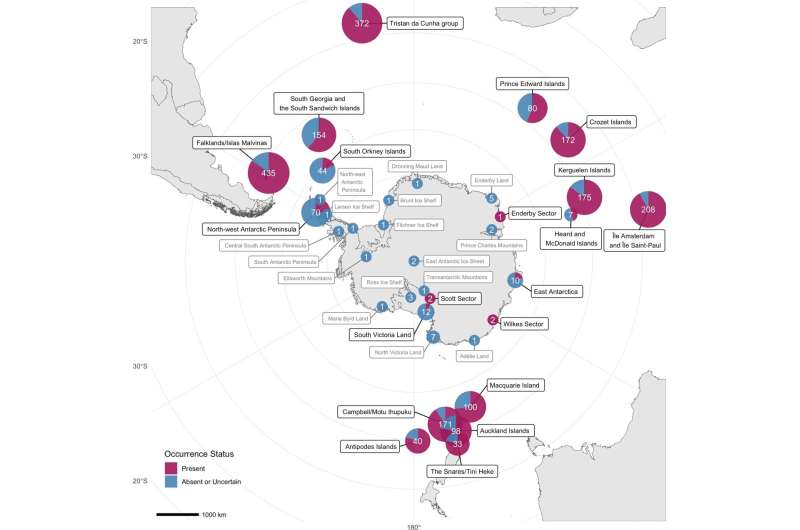This article has been reviewed according to Science X's editorial process and policies. Editors have highlighted the following attributes while ensuring the content's credibility:
fact-checked
peer-reviewed publication
trusted source
proofread
Alien plants and animals threaten Antarctica

While scientists globally have been tracking the impact of introduced, non-indigenous species into environments—this collaborative research between La Trobe University, the Arthur Rylah Institute and Monash University is the first to document alien species across the broader Antarctic region using modern bioinformatic standards, a region that is particularly vulnerable to the impact of climate change and introduced species of plants and animals.
The study, led by Dr. Rachel Leihy, from the Arthur Rylah Institute for Environmental Research and published in Scientific Data, is the first to collate data on the identity, localities, establishment, eradication status, dates of introduction, habitat, and evidence of impact of known introduced and invasive alien species for the terrestrial and freshwater Antarctic and Southern Ocean region, dating back to the first arrival of people in these areas and the first reports of alien species in the mid 1700's.
The study reviewed 3,066 records for 1,204 plants and animals in 36 individual localities across the Antarctic and Southern Ocean Islands.
According to Dr. Leihy, the evidence indicates that, while almost half of these alien species are not having an invasive impact, "Around 13% of species have managed to invade the local environment."
One of the reasons that data on alien species in the Antarctic has, to date, remained largely undocumented is because the region south of latitude 60°S is managed as an international space through the Antarctic Treaty System.
"The areas is often excluded from international reporting on agreements enforcing documentation of biosecurity breaches—such as the United Nations' Convention on Biological Diversity," Dr. Leihy said.
According to Prof Melodie McGeoch of La Trobe University, since the earliest expeditions to Antarctica and the Southern Ocean Islands, humans have intentionally and accidentally introduced non-native species to the region but few have taken hold on the continent itself because of the severity of the climate.
Following the entry into force in 1998 of the Protocol on Environmental Protection to the Antarctic Treaty, the introduction of domestic stock, sled dogs and non-sterile soil has been prohibited, and the introduction of living organisms subject to strict permit conditions.
"While on the comparatively milder Southern Ocean Islands, which encircle the continent and also form part of the Antarctic region—such as Australia's Macquarie Island, there are many more alien species records."
Some of these established aliens have caused significant impacts on local biodiversity.
These include widespread cat, mice, and rat predation on endemic insects and seabirds, vegetation damage caused by rabbits and other introduced mammals, and the transformation of some plant communities by weeds.
"However, despite increasingly stringent biosecurity procedures across the region, biological invasions remain a key threat to Antarctic ecosystems," Dr. Leihy said.
"This study—and the continued documentation of introduced species—into Antarctica is important to provide baseline data because projections indicate that the impacts of invasive alien species on their indigenous counterparts and on ecosystems are likely to grow into the future with increasing human occupancy of the region and with changing climates," she said.
More information: Rachel I. Leihy et al, Introduced and invasive alien species of Antarctica and the Southern Ocean Islands, Scientific Data (2023). DOI: 10.1038/s41597-023-02113-2
Journal information: Scientific Data
Provided by La Trobe University





















